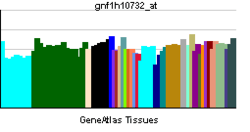GPR141
| GPR141 | |||||||||||||||||
|---|---|---|---|---|---|---|---|---|---|---|---|---|---|---|---|---|---|
| Identifiers | |||||||||||||||||
| Aliases | GPR141, PGR13, G protein-coupled receptor 141 | ||||||||||||||||
| External IDs | MGI: 2672983 HomoloGene: 18771 GeneCards: GPR141 | ||||||||||||||||
| Genetically Related Diseases | |||||||||||||||||
| obesity[1] | |||||||||||||||||
| |||||||||||||||||
| RNA expression pattern | |||||||||||||||||
 | |||||||||||||||||
| More reference expression data | |||||||||||||||||
| Orthologs | |||||||||||||||||
| Species | Human | Mouse | |||||||||||||||
| Entrez | |||||||||||||||||
| Ensembl | |||||||||||||||||
| UniProt | |||||||||||||||||
| RefSeq (mRNA) | |||||||||||||||||
| RefSeq (protein) | |||||||||||||||||
| Location (UCSC) | Chr 7: 37.68 – 37.83 Mb | Chr 13: 19.75 – 19.82 Mb | |||||||||||||||
| PubMed search | [2] | [3] | |||||||||||||||
| Wikidata | |||||||||||||||||
| View/Edit Human | View/Edit Mouse |
Probable G-protein coupled receptor 141 is a protein that in humans is encoded by the GPR141 gene.[4][5][6]
GPR141 is a member of the rhodopsin family of G protein-coupled receptors (GPRs) (Fredriksson et al., 2003).[supplied by OMIM][6]
References
- ↑ "Diseases that are genetically associated with GPR141 view/edit references on wikidata".
- ↑ "Human PubMed Reference:".
- ↑ "Mouse PubMed Reference:".
- ↑ Vassilatis DK, Hohmann JG, Zeng H, Li F, Ranchalis JE, Mortrud MT, Brown A, Rodriguez SS, Weller JR, Wright AC, Bergmann JE, Gaitanaris GA (Apr 2003). "The G protein-coupled receptor repertoires of human and mouse". Proc Natl Acad Sci U S A. 100 (8): 4903–8. doi:10.1073/pnas.0230374100. PMC 153653
 . PMID 12679517.
. PMID 12679517. - ↑ Fredriksson R, Hoglund PJ, Gloriam DE, Lagerstrom MC, Schioth HB (Nov 2003). "Seven evolutionarily conserved human rhodopsin G protein-coupled receptors lacking close relatives". FEBS Lett. 554 (3): 381–8. doi:10.1016/S0014-5793(03)01196-7. PMID 14623098.
- 1 2 "Entrez Gene: GPR141 G protein-coupled receptor 141".
Further reading
- Strausberg RL, Feingold EA, Grouse LH, et al. (2003). "Generation and initial analysis of more than 15,000 full-length human and mouse cDNA sequences.". Proc. Natl. Acad. Sci. U.S.A. 99 (26): 16899–903. doi:10.1073/pnas.242603899. PMC 139241
 . PMID 12477932.
. PMID 12477932. - Scherer SW, Cheung J, MacDonald JR, et al. (2003). "Human chromosome 7: DNA sequence and biology.". Science. 300 (5620): 767–72. doi:10.1126/science.1083423. PMC 2882961
 . PMID 12690205.
. PMID 12690205. - Gerhard DS, Wagner L, Feingold EA, et al. (2004). "The status, quality, and expansion of the NIH full-length cDNA project: the Mammalian Gene Collection (MGC).". Genome Res. 14 (10B): 2121–7. doi:10.1101/gr.2596504. PMC 528928
 . PMID 15489334.
. PMID 15489334.
This article is issued from Wikipedia - version of the 10/17/2016. The text is available under the Creative Commons Attribution/Share Alike but additional terms may apply for the media files.